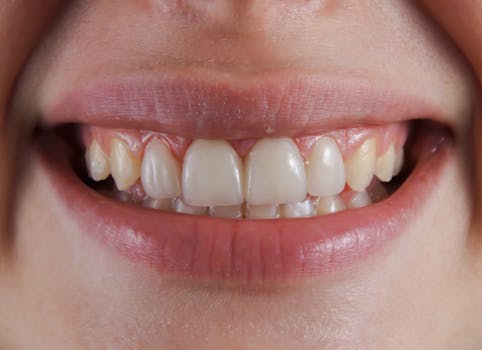Understand tooth structure and the function of the most important components of dental anatomy
The tooth (lat. "dens"), together with the bones, belongs to the hard tissue of the human body. The teeth are mainly used to crush and grind food. In humans, they also have the function of producing sounds for speech and the social aspect.



Teeth, therefore, play an important role in a person's life and should always be well cared for and looked after. For healthy oral hygiene and proper care, you also need background knowledge about the structure of the teeth.
Our teeth
Every person has a unique and individual set of teeth. No two teeth in the world are exactly alike. Just like fingerprints, teeth can be used to identify a person. Age, gender, DNA, diseases and much more can be read from a set of teeth.
The natural dentition of an adult person usually consists of 28 or 32 teeth - depending on the presence of wisdom teeth. Some people do not have wisdom teeth due to genetics; others often have them removed early due to lack of space.
There are 14 and 16 teeth in the upper and lower jaw respectively. Each tooth is very different in form and function. Humans have 8 incisors, 4 canines, and 18 or 20 molars, and a distinction is made between 8 premolars and 8 or 12 molars. The molars are central to the grinding of food. The incisors and canines are more responsible for biting off, separating and thus crushing parts of food.
Structure of the tooth
The human tooth anatomy consists of multiple layers of both soft tissue and hard tissue.
The crown and neck of the tooth
Every tooth consists of the tooth crown (Cora dentis), the tooth neck and root, and several layers.
The crown is the part of the tooth that is not covered by the gum. In a healthy tooth or gum, only the crown is visible. The gum usually covers the neck of the tooth. If the gum recedes due to a disease, the neck of the tooth becomes visible.
The tooth root
Every human tooth has a tooth root. The ratio, one to a maximum of two roots per tooth, applies mainly to incisors, canines and small molars. Large molars are considered multi-rooted teeth that have up to four root canals. The canines are again the teeth with the longest roots.
The root of the tooth and the neck of the tooth are surrounded by the root cementum. The root cementum is also part of the periodontal ligament. Besides water, tissue and fibres, it consists mainly of hydroxyapatite. The bone-like substance anchors the Sharpey fibres in its function. These fibres are flexible and cushion the pressure caused by chewing. Unlike dental implants, which are firmly attached to the jawbone and cannot move.
The tooth enamel
The tooth is made up of three layers.
The outermost layer is the enamel (adamantine) and covers the visible part of the tooth, the crown. Enamel is the hardest substance in the human body and is comparable in hardness to quartz.
Tooth enamel consists almost exclusively of minerals that make it extremely resistant. Plus, the fluoride it contains strengthens the enamel against decalcification caused by acids. This effect can be used to prevent caries by giving the tooth additional fluoride. On the other hand, once tooth enamel is destroyed, it is lost forever.
The degradation of the enamel (mostly by acids) is usually painless and hardly noticeable, which is why it is usually only detected in a very late stage.
The dentin
Beneath the enamel lies the dentin. The dentin surrounds the tooth nerve and is as hard as our bones. In the crown area, it is surrounded by adamantine and in the root area by dental cement. The dental cement anchors the tooth to the jawbone with the help of fibres. However, the cementum is not as resistant as the adamantine.
The inorganic component of dentin is similar to enamel and includes phosphate and calcium.
The tooth nerve (the pulp)
The pulp fills the inside of the tooth. It is also colloquially called the dental nerve because it contains nerve pathways. It is the most sensitive organ of the tooth. The pulp contains the aforementioned nerve fibres and lymph and blood vessels also run through it, supplying the tooth.
The dental bed explained
The dental bed is a functional system consisting of the gums (gingiva), the periodontium, the cementum and the bone surrounding the tooth (alveolar bone). All these supporting tissues absorb the stresses of the tooth.
The gum
The tooth is held in place by the gums and the periodontium. The gums are part of the oral mucosa and cover the neck of the tooth like a collar and also the edges.
Healthy gums are a light pink colour. They should not bleed when you touch them or brush your teeth. Systematic checking of the gums is important for detecting diseases and inflammations in the oral cavity.
For this reason, your gums are examined at every preventive or check-up examination with the dentist and during professional tooth cleaning. It is also important to floss between your teeth once a day to protect your gums.
The root cementum
The thin minimalised layer covers the root of the tooth from the neck of the tooth to the tip of the root. In addition, the root cementum is connected to the tooth socket via the fibrous tracts. This is because your tooth is not firmly fused to your bones, but is only suspended with the help of the fibrous apparatus. The fibres also support the chewing process by stimulating the bone-forming cells.
The root skin
The root skin cushions the chewing pressure when biting down. It encloses the entire root area of the healthy tooth and fills the gap between the bony tooth compartment and the root. Nerves are an important part of the root membrane and blood and lymph vessels.
Primary teeth
Your primary and permanent teeth are already present in your jaw at birth. The first milk tooth erupts around the sixth month of life. The permanent teeth usually erupt at the age of six.
Dental Bridge
A broken or missing tooth can be restored with a dental bridge. This can be made by your dentist with an artificial crown, denture or veneer. The bridge is supported by your natural teeth. A dental bridge offers several benefits, including restoring your smile, the ability to speak and chew, and maintaining your facial shape.
Dental care and tooth structure
To maintain your dental health and avoid gum disease, it is important to brush your teeth regularly. Daily dentistry care involves brushing the visible surfaces of your teeth, such as enamel, fissures and gums, especially the gum line. However, bacterial plaque buildup and food debris should also be removed. In this way, you protect your oral health from attack by micro-organisms, tooth decay and gum disease. If you have problems with your oral health you should speak to a healthcare professional.



